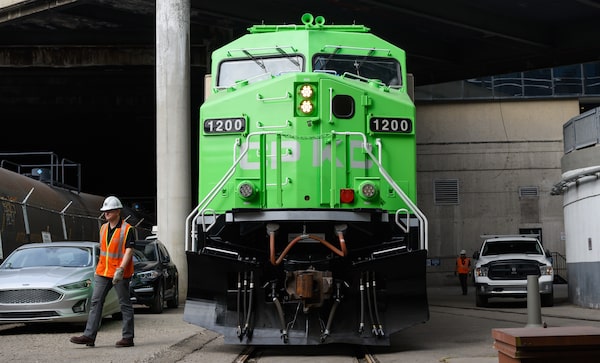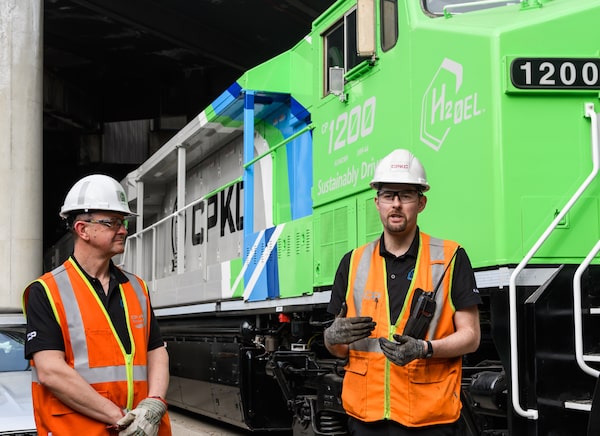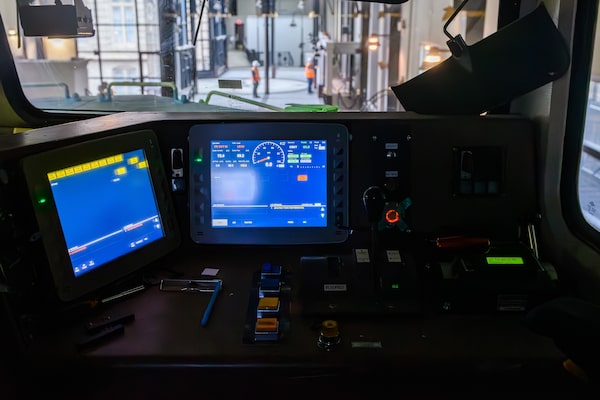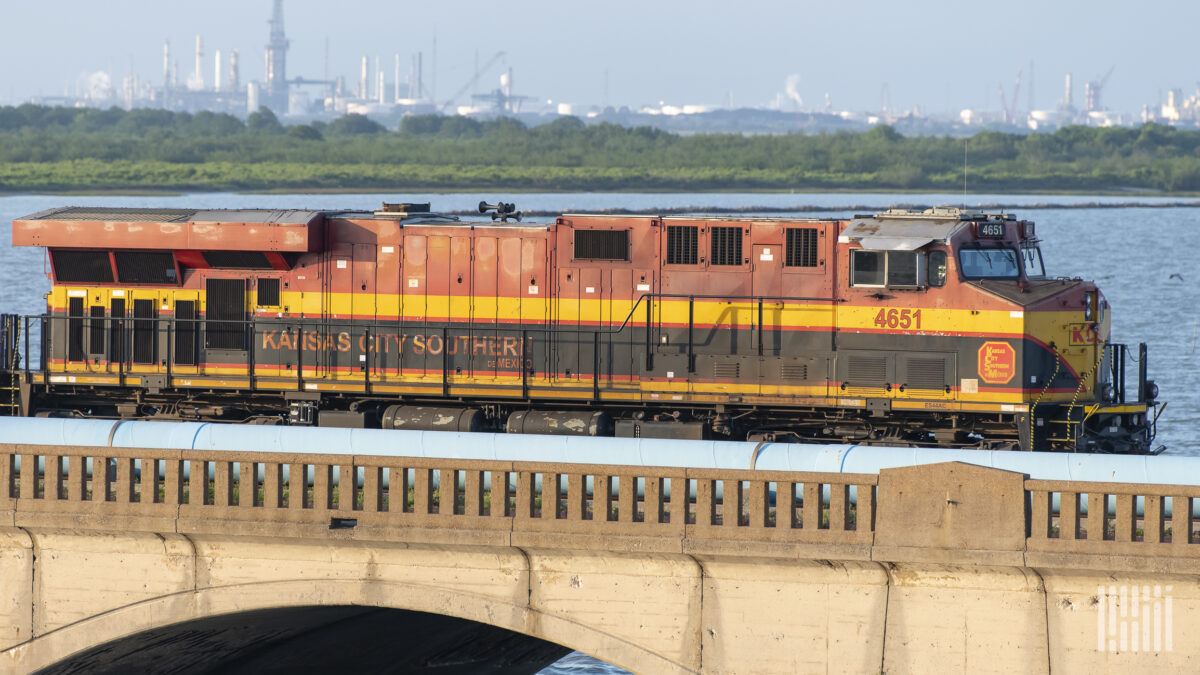A different kind of steam engine: How CPKC aims to decarbonize its fleet with hydrogen locomotives
KELLY CRYDERMAN
PUBLISHED 6 HOURS AGOU PDATED 2 HOURS AGO
FOR SUBSCRIBERS
 CPKC's third-ever hydrogen locomotive, and first-ever high-speed hydrogen locomotive in Calgary on March 19. JUDE BROCKE/THE GLOBE AND MAIL
CPKC's third-ever hydrogen locomotive, and first-ever high-speed hydrogen locomotive in Calgary on March 19. JUDE BROCKE/THE GLOBE AND MAIL
If you’re used to watching freight trains click by in Western Canada, a hydrogen fuel cell locomotive wouldn’t immediately stand out. It looks the same. It moves the same. It’s still steel wheels on steel rails.
However, when a crew member steps aboard one of these Canadian Pacific Kansas City (CPKC) Ltd. test locomotives, the first question is nearly always “Is it running?”
Compared with ubiquitous diesel-electric locomotives, the soundlessness of this vehicle undersells its power
. Occasionally, a compressor from the rear will sigh, but the main noise is a soft electrical hum. There is no noisy diesel engine and no smelly exhaust. The locomotive emits nothing but a stream of steam.
“We didn’t want to approach the public by showing renderings of what could be possible. We wanted to make sure we did what we said we would do and build something that works,” said Kyle Mulligan, assistant vice-president of operations technology at CPKC.
“Hydrogen could be considered a fuel of the future.”
Rail is sometimes viewed as an old industry or a low-tech one. But with its small fleet of
Alberta-designed and built fuel cell locomotives, CPKC has jumped ahead in the global race to harness the power of hydrogen. The simplest, lightest and most abundant element in the universe can be a low-carbon energy carrier and is seen by many as an integral part of any energy transition.
In October, 2020, the
Calgary-based company – then Canadian Pacific, or CP, before
a historic merger with Kansas City Southern last year – announced its plans to build a hydrogen-powered locomotive, based on a successful pitch from Dr. Mulligan to chief executive officer Keith Creel. Over the past 3½ years, the project team has grown from three people working with an $8.5-million budget to a group of 15 engineers, mathematicians and scientists with tens of millions of dollars at their disposal – much of it federal and provincial government funding.
 Kyle Mulligan, Assistant Vice President of Operations Technology, right, talks about CPKC's hydrogen locomotive on March 19.JUDE BROCKE/THE GLOBE AND MAIL
Kyle Mulligan, Assistant Vice President of Operations Technology, right, talks about CPKC's hydrogen locomotive on March 19.JUDE BROCKE/THE GLOBE AND MAIL
CPKC now has three diesel freight locomotives retrofitted with hydrogen fuel cells and lithium-ion batteries. It plans to build three more, all marked with a distinctive lime-green paint, by the end of the year. The software and electrical design is done in-house, and the fabrication and assembly is all done in Calgary or by
an Innisfail, Alta., contractor.
The company will test its 4,400-horsepower locomotive, the newest and most powerful of the first three, on the challenging grades of the Rocky Mountains in July – even travelling through the iconic loops of the Spiral Tunnels.
Some day, these prototypes and real-world tests could result in a massive transformation. “With the right funding support” from Ottawa and the Alberta government, Dr. Mulligan believes CPKC could decarbonize 65 per cent of its Canadian locomotive fleet – 700 vehicles on the busy tracks of Western Canada – within two decades.
“This locomotive you’re sitting in, this is designed for moving freight transcontinental. And no one has ever built something of this magnitude,” he said during a demonstration at CPKC’s downtown Calgary facilities, a stone’s throw from the 110-year-old Fairmont Palliser Hotel, built to accommodate passengers from Canadian Pacific’s westward expansion.
The hydrogen program fits in with the pragmatic green image the company is trying to cultivate. Mr. Creel already brags that rail transport is four times more fuel-efficient than trucking.
And he said
this year that part of what has driven initiatives such as the hydrogen program is the outlook of the company’s largest shareholder, Sir Christopher Hohn. The founder of London-based TCI Fund Management Ltd. has a legendary reputation for both his investor and climate activism.
“I met with him many, many times,” Mr. Creel said, speaking on the Business Council of Canada’s
podcast. “And in fact, based on one of those meetings, it drove action.”
There is an array of hydrogen passenger trains running in China and Europe – and, closer to home, in
Quebec’s Charlevoix region and
soon in San Bernardino, Calif. But Dr. Mulligan says CPKC’s high-power locomotives are much different, as they are meant to be workhorses on the busy freight lines that transport Western Canadian commodities such as grain, potash, sulphur and coal to Pacific ports (oil, which often travels by rail, moves mostly east and south).
“We’re ascending the Rocky Mountains. We’re pulling basically our heaviest train that we operate. We’re going across four very different seasons of weather,” Dr. Mulligan said.
 With a goal of having five hydrogen locomotives running in the near future on multiple routes including Calgary to Edmonton and Calgary to Golden, CPKC is hoping to model a new type of technology to demonstrate to other companies what is possible.JUDE BROCKE/THE GLOBE AND MAIL
With a goal of having five hydrogen locomotives running in the near future on multiple routes including Calgary to Edmonton and Calgary to Golden, CPKC is hoping to model a new type of technology to demonstrate to other companies what is possible.JUDE BROCKE/THE GLOBE AND MAIL
The challenges of making the new fleet as powerful as a diesel-electric locomotive are substantial. For instance, the fuel cells don’t leave a lot of room for the hydrogen fuel itself. To give the locomotives more range, the CPKC team fabricated a tender car that attaches to the locomotive and holds more hydrogen. If need be, direct-to-locomotive refuelling trucks can be deployed, too.
Odourless, colourless and tasteless, hydrogen is an energy carrier rather an energy source, per se. But it can be used to store, move and deliver energy produced from other sources. The hydrogen fuel cells convert hydrogen and oxygen into electricity and water.
It’s natural that a suite of hydrogen projects would go ahead in this province, whether it is Canada’s
first hydrogen community or Air Products and Chemicals Inc.’s
$1.6-billion net-zero hydrogen complex – both located near Edmonton. According to the Alberta government, Canada ranks in the top 10 of global hydrogen producers, and the province is the largest hydrogen producer in the country.
But similar to EVs, which are only as green as their source of electricity, where the hydrogen comes from matters. While using hydrogen doesn’t emit carbon dioxide, the energy-intensive processes to produce it do. Most commonly, the
world produces hydrogen from natural gas, as is the case in Alberta. And in 2022 Alberta produced two million tonnes of unabated hydrogen and half a million tonnes of natural gas-based hydrogen abated with carbon capture, utilization and storage (CCUS).
That latter category is called “blue hydrogen,” and that’s what CPKC plans to primarily use to power its locomotives in the near term. Dr. Mulligan said that by using low-carbon blue hydrogen “we’re at 83-per-cent reduction in overall emissions compared to diesel – for every locomotive converted.”



 www.freightwaves.com
www.freightwaves.com





